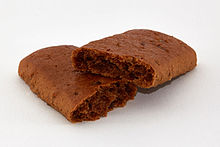This article needs additional citations for verification. (December 2010) |
Aachener Printen are a type of Lebkuchen originating from the city of Aachen in Germany. Somewhat similar to gingerbread, they were originally sweetened with honey, but are now generally sweetened with a syrup made from sugar beets.
 A herbal Aachener Printe broken in half | |
| Type | Lebkuchen |
|---|---|
| Place of origin | Germany |
| Region or state | Aachen |
| Main ingredients | sugar beets, spices (cinnamon, aniseed, clove, cardamom, coriander, allspice, ginger) |

The term is a protected geographical indication, meaning that all manufacturers must be located in or near Aachen.[1]
History edit
Aachener Printen were at least partially created due to the numerous pilgrims who wanted to visit the Aachen Cathedral. The Printen were probably inspired by Conque de Dinant, a pastry from Dinant that was usually baked in the form of figurative representations or artistic braids.[2] Gebildbrot came to Aachen in the 15th century with immigrant blacksmiths and quickly found popularity among the city's bakers. They made a soft dough sweetened with honey, which they pressed into elaborately carved baking molds depicting saints and other figures. The Aachener Printen became what they are now in 1806, when the French emperor Napoleon blocked the British trade routes and with them Aachen's supply of cane sugar and honey, the most important ingredients for the pastry. The bakers replaced the sweeteners with sugar and syrup from local beets. An original baker named Henry Lambertz then came up with the idea of rolling out the dough over raised molds. The robust cookies can be efficiently produced in large quantities and are ideal as travel provisions, which is why their reputation has spread far beyond Aachen. The Lambertz-Gruppe, founded in 1688, is Aachen's oldest and largest manufacturer of Printen.[3][4]
Production edit
Originally sweetened with honey, nowadays Aachener Printen are sweetened with the syrup from sugar beets as honey became temporarily unavailable when Napoleon issued a trade embargo, banning all trade with the main supplier of honey, the United States. The tradition of sweetening with sugar beets was kept even after Napoleon was defeated and the French occupation lifted.
Printen are made from a variety of ingredients including cinnamon, aniseed, clove, cardamom, coriander, allspice and also ginger. The exact mixture of these ingredients, however, is a close kept secret of the individual Printen bakeries.
Additionally to the original Printen, there are also Printen with nuts (usually almonds), covered in chocolate or glaze and marzipan.
See also edit
References edit
- ^ eAmbrosia. The EU geographical indications register. "Aachener Printen". ec.europa.eu. Retrieved 2023-01-01.
- ^ "La couque de Dinant et de Rins". City of Dinant. Retrieved 5 October 2014.
- ^ "Steinhart, duftend, lecker: Kulturgut Aachener Printen". National Geographic.
- ^ Florian Langenscheidt, Bernd Venohr (Hrsg.): Lexikon der deutschen Weltmarktführer. Die Königsklasse deutscher Unternehmen in Wort und Bild. Deutsche Standards Editionen, Köln 2010, ISBN 978-3-86936-221-2, S. 45–50.
Further reading edit
- Kittelberger, Karl F. (1988). Lebkuchen und Aachener Printen - Geschichte eines höchst sonderbaren Gebäcks [Lebkuchen and Aachen Printen - History of a very strange type of pastry] (in German) (1 ed.). Aachen, Germany: Meyer & Meyer Verlag. ISBN 3-89124-069-4. (192 pages)
- Kittelberger, Karl F. (1991). Das Aachener Printenbuch - Auflösung ihrer rätselhaften Geschichte [The Aachen Printen book - Resolution of its mythological history] (in German) (1 ed.). Aachen, Germany: Meyer & Meyer Verlag. ISBN 3-89124-117-8. (102+2 pages) (NB. This book is a shortened issue of the same author's 1988 work, focusing on Printen.)
- Setzen, Werner (1996) [1985]. Aachener Printenbrevier [Aachen Printen brevier] (in German) (2 ed.). Aachen, Germany: Meyer & Meyer Verlag. ISBN 3-89124-328-6. (79+9 pages) (NB. A third edition was published in 2009.)
External links edit
- Aachener Printen
- Aachener printen
- Aachener printen Archived 2021-04-19 at the Wayback Machine